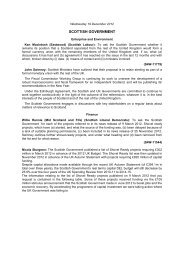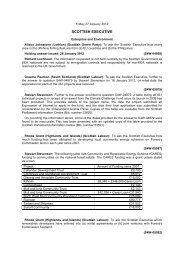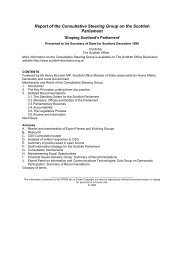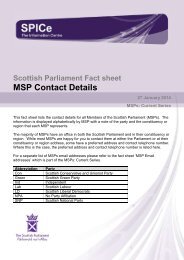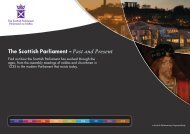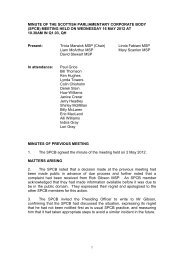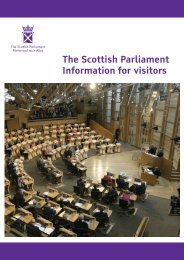Comparative Study - Scottish Parliament
Comparative Study - Scottish Parliament
Comparative Study - Scottish Parliament
Create successful ePaper yourself
Turn your PDF publications into a flip-book with our unique Google optimized e-Paper software.
The purpose of this unit is to allow pupils to develop a wider<br />
understanding of the way architects and artists influence each other<br />
in the design process. While producing original works they may have<br />
drawn on a number of sources to achieve this end.<br />
The aim of this unit is to provide a resource that will allow either a<br />
school or site based comparative study of the work of the architect<br />
Enric Miralles in the <strong>Scottish</strong> <strong>Parliament</strong> with other artists who may<br />
have helped to influence his design. For the purpose of this study,<br />
Charles Rennie Mackintosh has been chosen as another artist,<br />
although other people could be used, e.g. Antoni Gaudi.<br />
The unit is sub-divided to allow the lessons to be carried out over<br />
several weeks, but equally each of the lessons can be used as<br />
freestanding lessons.<br />
This unit is aimed at 5-14 Level C to allow the teacher to<br />
differentiate by either simplifying or extending the activities to meet<br />
the diversity of abilities within a class.<br />
Learning Outcome: Evaluating and appreciating.<br />
Strands: Observing, reflecting, describing and responding.<br />
Using visual elements: pattern<br />
Using media<br />
Attainment Targets:<br />
• Consider and discuss a range of artists’ and designers’ work<br />
sources using basic vocabulary and indicating a few similarities<br />
and differences.<br />
• Using appropriate vocabulary, make comparisons of art and<br />
design works.
By exploring the similarities and differences of the work of Enric<br />
Miralles in the <strong>Scottish</strong> <strong>Parliament</strong> and the artist Charles Rennie<br />
Mackintosh, pupils will be able to appreciate how artists may influence<br />
each other’s ideas/works.<br />
Background<br />
The <strong>Scottish</strong> <strong>Parliament</strong> building is an excellent context to review the<br />
diversity of architectural design and comparative artistic influences.<br />
Enric Miralles, the architect of the <strong>Scottish</strong> <strong>Parliament</strong>, became aware of<br />
the work of Charles Rennie Mackintosh whilst studying in Glasgow. There<br />
are several examples within the <strong>Scottish</strong> <strong>Parliament</strong> of how Miralles’<br />
ideas may have been influenced by Mackintosh.<br />
One example is the fencing surrounding The <strong>Scottish</strong> <strong>Parliament</strong> building,<br />
designed by Miralles, shown in photograph (a). When compared to<br />
photograph (b) - a Charles Rennie Mackintosh design, the fine ironwork<br />
and ‘petal/leaf-like’ motif of the fencing in photograph (a) could be<br />
reminiscent of the Mackintosh style and design.
a) b)<br />
© Architecture on Disc / Licensed via www.scran.ac.uk<br />
Railings around the <strong>Scottish</strong> <strong>Parliament</strong> Building<br />
(Miralles)<br />
Railings around the Glasgow School of Art (Mackintosh)
Pupil Activities<br />
1. Look at Photograph (a).<br />
An architect called Enric Miralles designed these railings.<br />
• What type of materials are the railings made of?<br />
• What kind of patterns can you see in the railings?<br />
• What sort of patterns or shapes do you think Enric Miralles<br />
was thinking of when he designed the railings?<br />
• Are the shapes like anything you may see in everyday life?<br />
2. Look at Photograph (b).<br />
These railings were designed by Charles Rennie Mackintosh.<br />
• What type of materials are the railings made of?<br />
• What kind of patterns can you see in the railings?<br />
• What sort of patterns or shapes do you think Charles Rennie<br />
Mackintosh was thinking of when he designed the railings?<br />
• Are the shapes like anything you may see in everyday life?<br />
3. Compare Photographs (a) and (b). Make some sketches of the<br />
patterns that you can see which show similarities and differences.
Linked Practical Lessons<br />
The following lessons using Photograph (a) as a stimulus can be used to<br />
develop an understanding of the pattern work in Miralles’ design.<br />
Strands: Using visual elements: pattern<br />
Using media<br />
String Bas-relief<br />
Materials: photograph (a)<br />
tracing paper<br />
pencils and white coloured pencils.<br />
black sugar paper,<br />
PVA glue,<br />
string,<br />
art straws<br />
Process<br />
1. Take piece of tracing paper the same size as the photograph. Trace<br />
the design of the railings. Turn the paper over and gently shade<br />
this surface with the lead pencil. Then turn the paper over again.<br />
2. Take a piece of black sugar paper. Now place the tracing paper on<br />
top of it with the original side up. Write over the traced lines,<br />
keeping the paper exactly in place. This will transfer the image<br />
onto the paper.<br />
3. Glue along the lines that you have made with PVA glue. Place the<br />
string or art straws along the pattern.<br />
4. If you would prefer not to use the string or art straws, you can<br />
alternatively draw along the lines with white pencil.<br />
A negative image can be achieved using the above technique with a black<br />
notewriter/pencil or string on white paper.<br />
Repeated Pattern<br />
Strand: Visual Elements - pattern<br />
Materials:<br />
scissors<br />
glue<br />
sugar paper
Process<br />
1. Take a rectangular piece of sugar paper. Fold it into at least 4<br />
vertical sections.<br />
2. Draw a section of the pattern onto the paper and cut it out (similar<br />
to making a paper chain).<br />
3. Choose a contrasting colour of paper for backing paper and glue the<br />
cut-out onto it.<br />
A silhouette effect can be created using this technique. The black paper<br />
pattern could alternatively be applied to a brightly coloured wash.<br />
There is opportunity to discuss colour, contrast, tone, and shape<br />
Stained Glass Window<br />
This technique is similar to the repeated pattern technique above, where<br />
the darker pattern line can be emphasised against a coloured background.<br />
1. Fold an A4 piece of paper into 4 or 8 sections.<br />
2. Cut out a leaf motif, keeping a join at the folded corner.<br />
3. Open up the paper, where you will see that the pattern has been<br />
repeated.<br />
4. Apply different colours of sugar paper to the open sections.<br />
The pattern activities could lead onto designing wrapping paper, notelets,<br />
cards, etc.<br />
Further activities that could be adapted to these designs include press<br />
print, wax resist/paint, tabletop printing, graffito, etc.
Ideally a visit to the <strong>Scottish</strong> <strong>Parliament</strong> Building would allow pupils to<br />
explore the architectural design.<br />
By observing:<br />
• barriers<br />
• connections<br />
• structure<br />
• and transparencies<br />
they can identify and make comparisons of how the architect’s ideas may<br />
have been influenced by other artists.<br />
This would provide excellent opportunity for quick sketching activities if<br />
the students were given sketch books. Pupils could be given a digital<br />
camera to record the images they have seen to make comparisons. Please<br />
note, there are restrictions on photography and the opportunity for<br />
sketching in some areas of the <strong>Parliament</strong>.<br />
If you are unable to visit the <strong>Scottish</strong> <strong>Parliament</strong> the photo resource<br />
sheet (see below) can be copied and further images can be downloaded<br />
from the <strong>Scottish</strong> <strong>Parliament</strong> Web site.
Photograph Resource Sheet<br />
1. Photographs of Enric Miralles’ Design at the <strong>Scottish</strong> <strong>Parliament</strong> Building.<br />
2. Examples of Charles Rennie Mackintosh’s Designs.<br />
© Architecture on Disc / Licensed via www.scran.ac.uk © Edinburgh College of Art /<br />
Licensed via www.scran.ac.uk<br />
© Glasgow School of Art / Licensed via<br />
www.scran.ac.uk<br />
© Glasgow School of Art / Licensed via<br />
www.scran.ac.uk




